The Beauty of queerness
How community members are using clothing to express their identities in the 2020s.
Friends Harlow Isham (left) and Hadley Hudson (right) stand together on the lawn outside Western Washington University’s Wilson Library, Tuesday, May 10. Clothing helps individuals express identity in the queer community // photo by Cameron Baird
Written by Cameron Baird
The queer community is as multidimensional as the world we live in.
Despite a history of adversity, the queer community continually adapts to change by deconstructing identity from the inside out.
Through it all, self-expression has remained intrinsic to the queer experience as individuals signal their existence through what they wear and how they act in order to take up space.
Images of queer self-expression have influenced fashion throughout history. At the turn of the 20th century, figures like Oscar Wilde, Marlene Dietrich and Kathrine Hepburn used clothing to redefine gender norms.
In more recent history, LGBTQ+ musicians and celebrities such as Elton John, David Bowie, Billy Porter, Laverne Cox and Janelle Monae used fashion as political identifiers to push the social constructs of gender and sexuality.
No other historical event was as consequential in redefining queer fashion as the 1969 Stonewall Riots in New York City, which are often credited as the inspiration for the modern queer liberation movement.
The movement, predominantly led by Black, transgender women, helped redefine traditional, gendered fashion trends and inspired subgenres like disco and punk.
Today, young queer people are exploring their identities through clothing as the COVID-19 pandemic and the influence of social media and discourse around bodily autonomy are changing the way people dress.
“I like fashion because I feel like that is one aspect of your appearance that you have total control over,” said Raven Klingele, a fourth-year student at Western Washington University.
Klingele said her clothing helps her feel confident when she’s insecure.
She said she takes style inspiration from 70s fashion and likes how they blend traditionally-masculine and traditionally-feminine elements alongside each other.
“I don’t care about this idea of what is beautiful or what is trendy,” Klingele said. “I can just pick clothes that make me happy, and that express something about myself.”
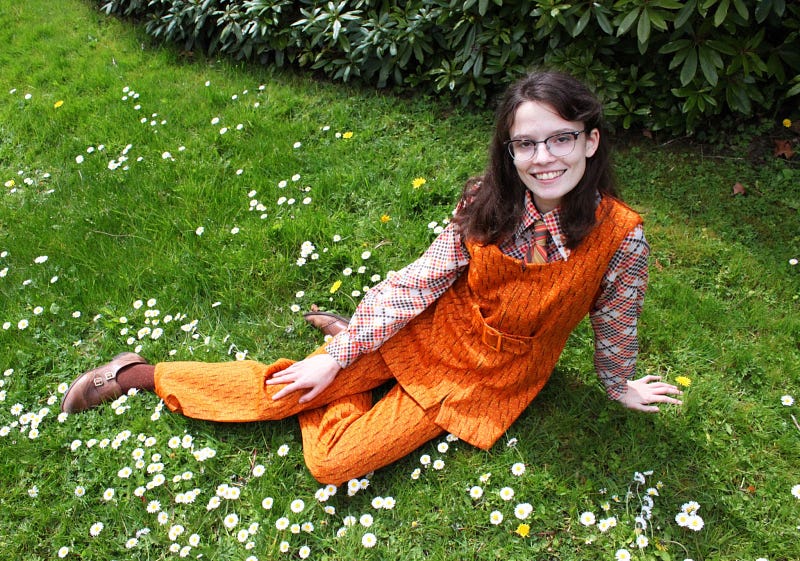
Raven Klingele lays on the lawn outside of Western Washington University’s College Hall, Friday, April 29. “I don’t care about this idea of what is beautiful or what’s trendy,” she said. “I can just pick clothes that make me happy and that express something about myself” // photo by Cameron Baird
Through her love for fashion, Klingele was inspired to create her own drag-king persona after going to drag shows at Bellingham’s Rumors Cabaret. In drag, her style combines two of Klingele’s favorite things: horror and disco.
In April, Klingele performed for the first time in drag at Western’s 30th-annual drag show.
“What I like about drag is that I can kind of escape being a woman for a while,” she said.
As a woman, she says the thought of being sexualized or objectified is always in the back of her mind. As a performer, she worries less about how others perceive her.
“As a man, I can do whatever I want,” she said. “I can make a fool of myself, and I can be this, kind of, overly-sexualized character.”
For Nävouny Divinne, another student and drag artist at Western, drag was her introduction to the queer community.
In seventh grade Divinne started watching drag queens do their makeup on YouTube, which inspired her to try it herself.
“I started doing makeup within a year of coming out,” she said. “And it has been intrinsic to my experience.”
Her first time performing in drag was also at Western’s 30th-annual drag show. Divinne says she is excited to see more transgender performers like herself be accepted in the drag community.
“We’ve always been part of the community and it’s just so wonderful to see us opening the floodgates for everyone,” she said.
She said that thanks to media representation like RuPaul’s Drag Race, she feels we’re in a “renaissance of drag.”
For Divinne, drag is an extension of herself rather than a separate entity. She said she considers herself “in drag” when she puts on makeup.
“I really don’t consider their distinctions,” she said. “Sometimes I look like this, sometimes I have glitter all over my body, sometimes I have black liner to my temples.”
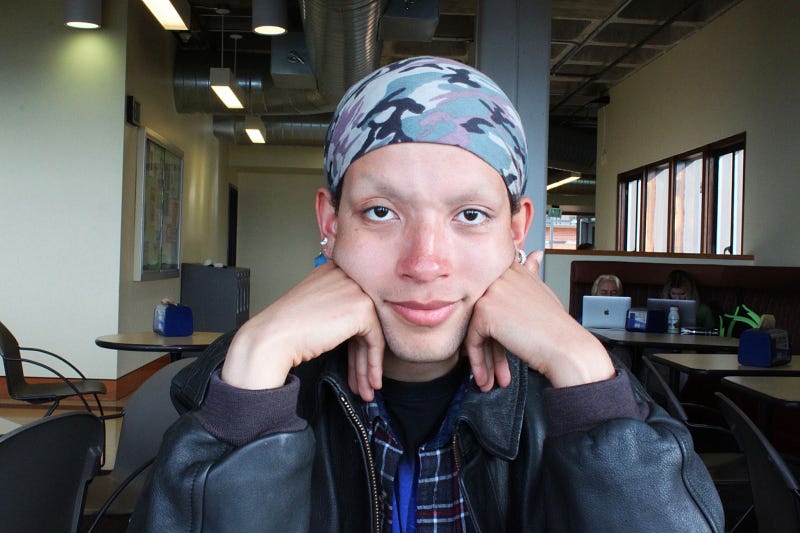
Nävouny Divinne sits inside Western’s Viking Union, Friday, April, 29. “We’re sort of in a renaissance of drag where people are so creative and I just can see good things coming,” she said // photo by Cameron Baird
When it comes to fashion, Divinne asserts that there are no limits to her self-expression.
“There’s no rules to art. There’s no rules to drag. There’s no rules to life,” she said.
Alpha Q, a drag queen based in Olympia, WA, first got into drag after coming to Western. Born and raised in Alaska, Q said that they found an accepting queer community after moving to Bellingham, which allowed them to explore their self-expression.
Q describes their style in drag as “old-school.”
“I like old, big ball gowns. I like sequins and I like rhinestones,” they said.
Outside of drag, their style fluctuates based on the space they’re in. If it’s a queerer space, they said they feel comfortable wearing more makeup and jewelry, but if it’s a predominantly heteronormative space they might “tone it down” more.
“Olympia has a mixed crowd,” they said. “Some people are very great and accepting, and some people are really not. You never really know what you’re going to get.”
They said they see their drag persona, Alpha, and their “real identity,” Daniel, as “two different sides of the same multi-sided coin.”
As a nonbinary person, they say it can be difficult to navigate spaces where clothing promotes the gender binary, but a person’s gender identity doesn’t come down to what kind of clothing they wear.
“That’s ultimately what started the whole Stonewall riots,” they said. “People being told you have to wear this many pieces of clothing in your own gender in order to be viewed as cisgender.”
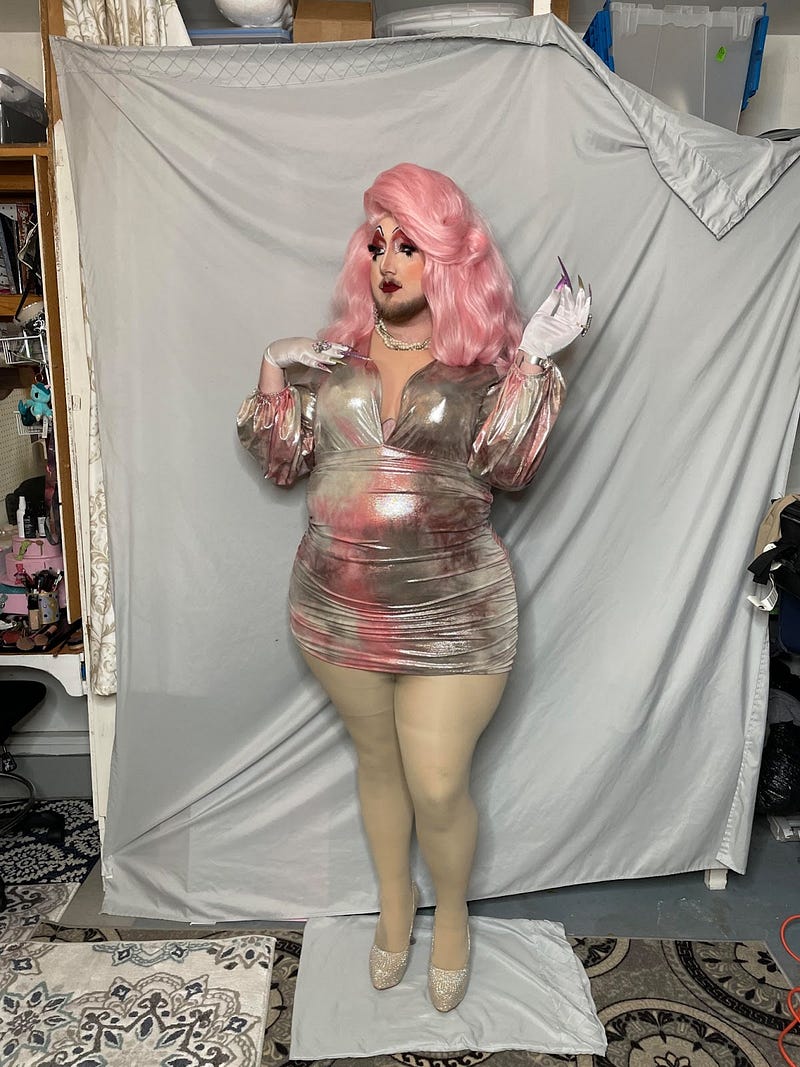
Alpha Q, a drag queen based in Olympia, WA, stands wearing gloves, pink hair and a metallic mini dress. They said they see their drag persona, Alpha, and their ‘real identity,’ Daniel, as ‘two different sides of the same multi-sided coin’ // photo courtesy of Awlknight Entertainment
Outside the drag community, queer people are also using clothing as ways to communicate who they are to the world.
“Fashion is the first thing that you really notice about somebody in a lot of ways, which is really cool. And I really like that aspect of life that you can kind of curate yourself to how the world will perceive you,” said Lauren Wallach, a fourth-year psychology student at Western.
When it comes fashion, she said queer people have the ability to create meaning from the clothes they wear.
“As a bisexual woman, wearing a piece of clothing kind of makes that bisexual itself,” she said.
Wallach said gender and sexuality also make her consider the distinction between being a woman and being feminine.
“I don’t think that those are the same thing,” she said. “I definitely think that I feel like I dress like a woman every time I put clothes on because I am a woman, but I don’t always feel like I’m dressing feminine.”

Lauren Wallach, a fourth-year psychology student at Western, pairs a corduroy jacket with a patterned scarf, Wednesday, May 4. “As a bisexual woman, wearing a piece of clothing kind of makes that bisexual itself,” she said // photo by Cameron Baird
For Tunny Parrish, a fourth-year student at Western, clothing is a way to own their identity.
When they came out as transgender in high school, they said they felt they had to “prove” their gender to others through what they wore.
“After graduating high school in June 2018, I basically just wore a t-shirt, a pair of jeans and a pair of shoes.” Parrish said.
Parrish went to the University of Washington before transferring to Western at the start of the pandemic. During the height of lockdown, they said they only left their house to get groceries.
“If I’m only going to go out once a week, I might as well wear something funky,” they said.
They said that they want to defy the social construct of gender by dressing like a clown; a term they are choosing to weaponize against the gender binary and the performative nature of gender.
“I dress in a lot of primary colors, and I have bright colored hair,” they said. “If my gender is a performance, then people are booing me and throwing tomatoes and the big hook is coming in to pull me off the stage.”
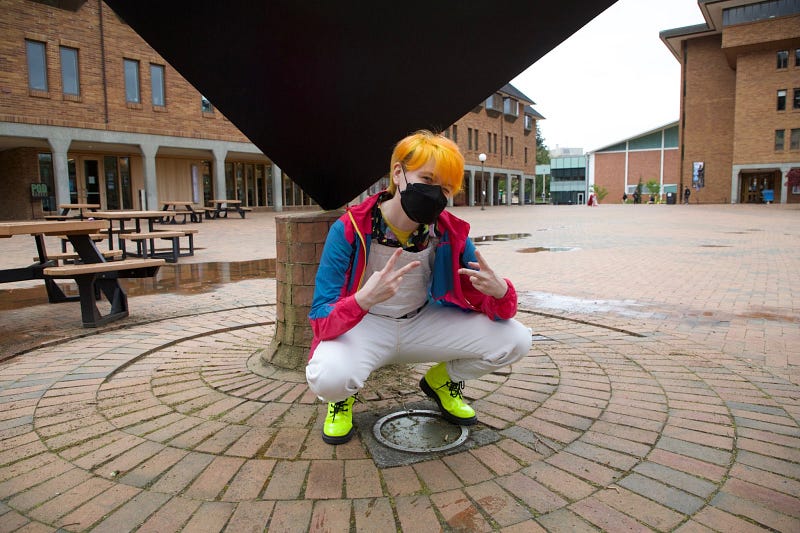
Tunny Parrish flashes two peace signs in Western’s Red Square, Tuesday, May 3. “If my gender is a performance, then people are booing me and throwing tomatoes, and the big hook is coming in to pull me off the stage,” they said // photo by Cameron Baird
Felix Trivazne said clothing has the ability to express a “multiplicity of selves.”
“I’m a trans man, but I don’t strongly identify with any particular gender,” he said. “I kind of like when someone looks at me and they’re like, ‘I’m not really sure if that’s a man or a woman.’”
He said that clothes give him the ability to shapeshift and change his image over time.
“I can dress like a cowboy, or I can dress like a princess,” he said.
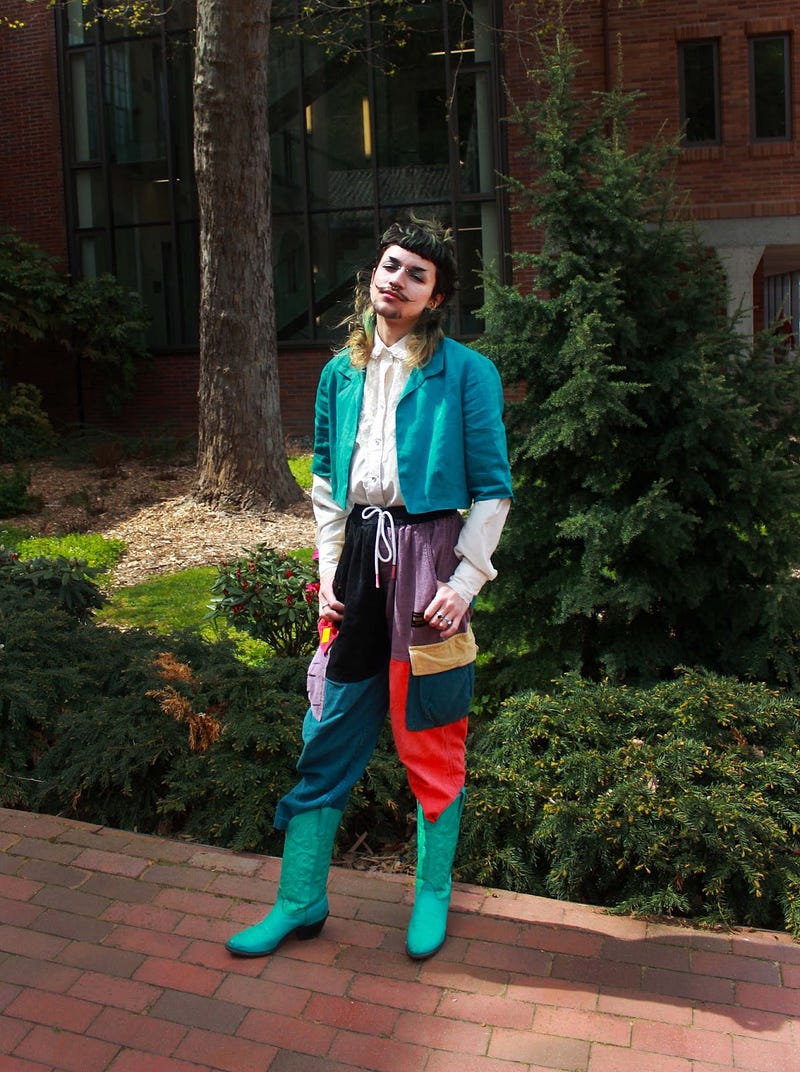
Felix Trivazne sports a pair of green cowboy boots and matching top, Thursday, May 12. “I’m a trans man, but I don’t strongly identify with any particular gender,” he said // photo by Cameron Baird
Harlow Isham, a fourth-year agroecology student at Western, said that their experience with clothing has been complicated.
“I don’t identify as binary,” they said. “I’ve had this experience of balancing the feeling I should be presenting a certain way through clothing, and also being drawn to my own personal aesthetic style.”
Isham said that in agriculture, queer people are not as visible. When farming, they said they feel pressure to dress more masculinely and practicality rather than any personal aesthetic.
“I really try to find a point in between the practical and the stylish and the fun and the flirty. All of that. Which looks different all the time,” they said.
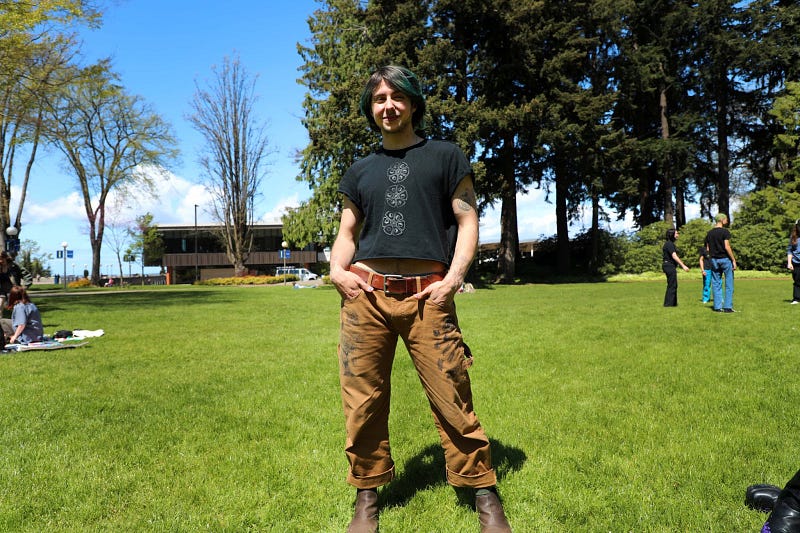
Harlow Isham stands on the lawn outside of Western’s Wilson Library, Tuesday, May 10. “I really try to find a point in between the practical and the stylish and the fun and the flirty and all that which looks different all the time,” they said // photo by Cameron Baird
Hadley Hudson, a Western student at the Fairhaven College, said that as she grew up, clothing allowed her to express herself more freely.
“I grew up going to a K-8 grade school where we had to wear uniforms,” she said. “Once I got into high school and had the freedom to wear something that wasn’t a polo and khakis it was overwhelming but also really exciting.”
During lockdown, Hudson said she kept busy by transferring drawings from her sketchbook onto Shrinky Dinks to make earrings. Her art style includes a lot of natural imagery as well as designs containing vibrators, penises and vaginas.
Hudson said she wants to use her art as a way to make people talk more openly about sex.
“I feel like it’s really important to just create conversations about those things,” she said. “It’s just like — now we’re talking about vaginas — now we’re talking about sex.”
She also said she wants to encourage people to experiment with their clothing and feel confident in their style.
“I want other people to know they can wear whatever they want,” she said. “There’s nothing that looks good on just one person.”
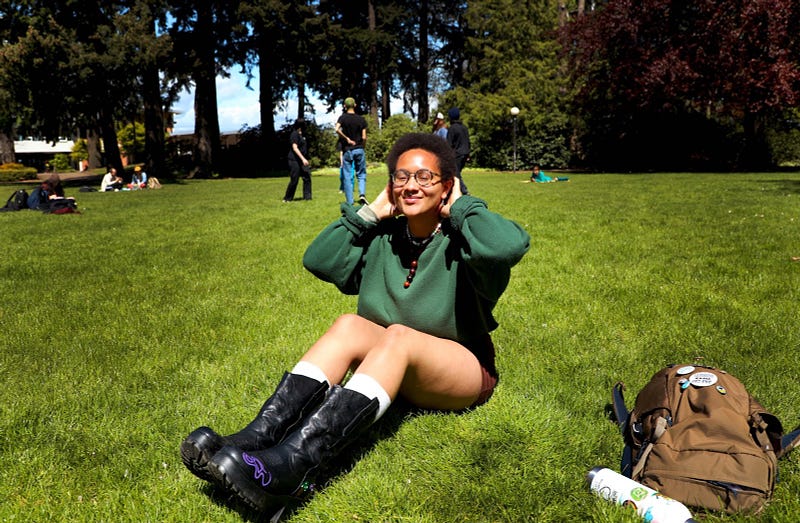

(left) Hadley Hudson sits on the lawn outside Western’s Wilson Library, Tuesday, May 10. (right) Hudson holds the earrings she designed. “I want other people to know they can wear whatever they want,” she said // photos by Cameron Baird
Bali Schaefer, a student at Western, has been designing theater costumes for eight years and recently has started their own clothing brand, Battery Acid Design. Their designs take vintage silhouettes and reimagine them through a modern lens.
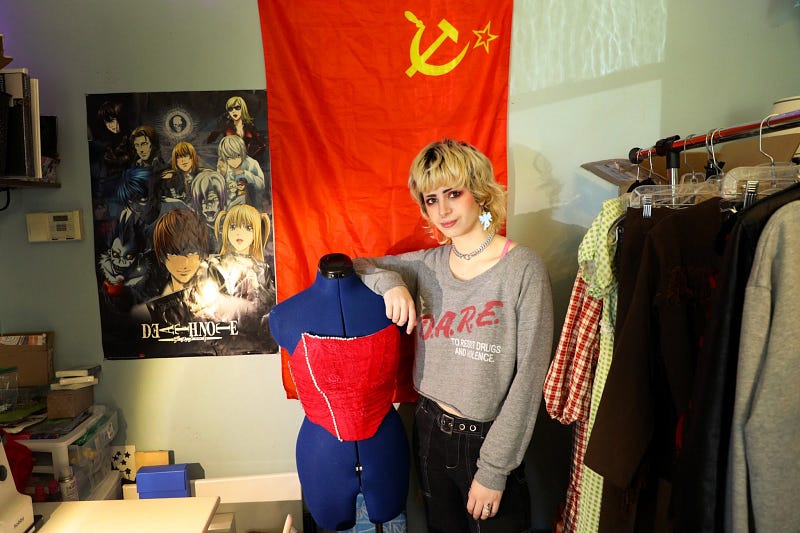
Bali Schaeffer stands next to a red corset they are designing for their brand Battery Acid Design, Sunday, May 8. “There’s different social aspects of fashion and clothes,” they said // photo by Cameron Baird
Schaeffer said that costuming and fashion have a lot in common, and people’s clothing are a lot like “social costumes.”
“There’s different social aspects of fashion and clothes,” they said. “You’re not going to wear a ballgown to your office job, but you’re not going to wear a pencil skirt and a blazer to a big party.”
As a creator, Schaeffer said that they want to bring queerness into everything they make, and want other queer individuals to wear their designs, too.
They said they believe identity and self-expression go hand in hand, but they are not the same. While your style can fluctuate from day to day, your inner identity remains the same.
“My identity and my self-expression don’t always line up, but I am still expressing who I am,” they said.
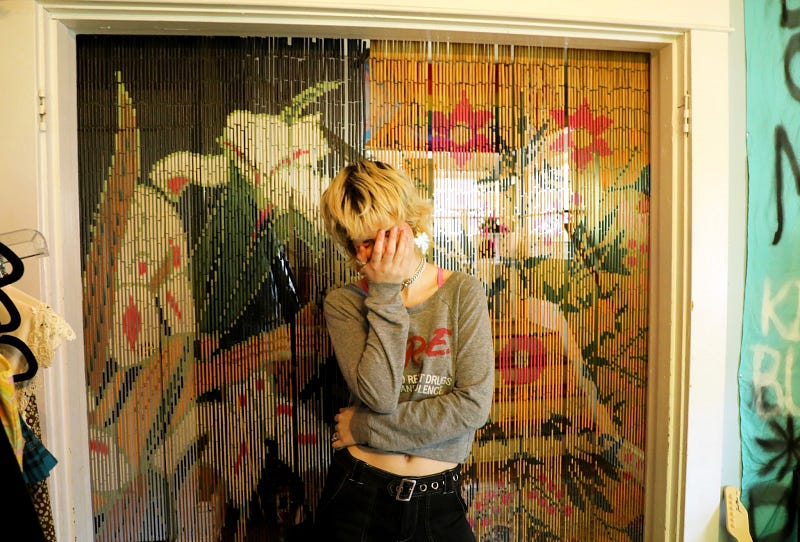
Bali Schaeffer stands with their hand covering their face in their Bellingham apartment, Sunday, May 8. “Once I stopped dressing the way other people did to fit in and started dressing the way I wanted to, I felt a lot better about myself, and I was a lot happier, too,” they said // photo by Cameron Baird
They said that when you’re able to express yourself more freely, you feel better on the inside.
“Once I stopped dressing the way other people did to fit in and started dressing the way I wanted to, I felt a lot better about myself, and I was a lot happier, too,” they said.
In today’s world, the relationship between identity and what kind of self-expression is seen as permissible is changing.
Schaeffer said that social media and the rise of apps like TikTok and Depop promote thrifting and emphasize individual style.
“I think it’s great for people to reuse items and find their own personal style,” they said. “But I also think that it’s causing overconsumption of fashion.”
Queer fashion is also at a crossroads in terms of how people are expressing the ownership of their bodies as bodily autonomy and reproductive rights are being threatened in the U.S..
Florida’s Parental Rights in Education bill, Alabama’s Vulnerable Child Protection Act and the potential reversal of Roe v. Wade are threatening people’s identities and livelihoods.
But, as history has shown, queer people are resilient and continue to push boundaries with expression.
“Queer fashion can be anything you want it to be,” said Schaeffer. “There’s so many different facets of queer people.”

